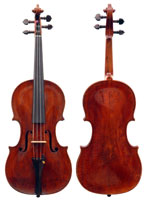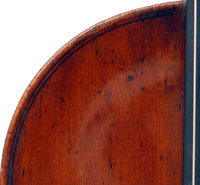|
Ref : 0940
A good English violin from the studio of
|

go to Home Page see more Violins |
Just enough of the fragmented label remains in this old English violin to positively identify it as being that of James Longman, an important dealer who operated in London from 1741 to 1798. The London expert, Ben Hebbert, pointed out that this label was presumably used by Longman before he went into partnership with Charles Lukey in 1769, so one can safely assume that this violin dates from before that partnership.A number of important English violinmakers worked for Longman at different times, notably Benjamin Banks, but also Alexander Kennedy and others who were trained in Barak Norman's workshop. Interestingly, some of Benjamin Banks's instruments bear the Longman label.
At this time the individual maker of this violin is unknown, but the hope is to establish its authorship in due course.
One is struck by this violin's beautiful color - a rich brown with a tinge of red, all original. The arching is full and beautifully graded. The Fs are nicely positioned and balanced. A peculiarity is that the top is from one piece of spruce, as is the entire lower rib from corner to corner. The purfling is painted in - something often encountered in English violins from that period.
The scroll in this violin is highly individualistic, really elegant, balanced and refined, and is very reminiscent of the work of Richard Duke. It certainly is quite unlike the more perfunctory scrolls often seen in studio work. It may eventually assist in identification of the maker.
Further, the neck graft in this violin is performed at the neck root, rather than the scroll, in which it appears that a 'spacer' system is fitted into the neck block and the original neck is then grafted onto it, instead of the later method of grafting the scroll onto a completely new neck. (See the composite photo showing this work.)
The nicest thing about this violin is its tone. It is really well-toned - rich, mature, focussed and with a very easy and open response. It has utterly seduced every violinist who has tried it and currently I have adopted it as 'personal violin' which I use for my own playing. It is extremely pleasant and rewarding to work on, leaving one with a sense of gratitude for experiencing a sound that can only reach this level of maturity over centuries - in this case over around 250 years - a real privilege to play on.
This instrument would convert and respond well to a baroque setup.
 |
 |
 |
||
 |
Dimensions : Length of back: 35.6 cm
Condition : Repairs were done long ago to some body cracks, but there are no cracks anywhere near the bridge or the soundpost area. These repairs appear well done. The front top treble corner has been rebuilt.
The violin is structurally secure.
Provenance : The property of Johan Grobbelaar
Price : P.O.A.
 |
 |
 |
 |
 |
 |
 |
 |
 |
 |
 |
 |
|||||
 |
 |
 |
 |